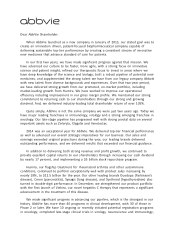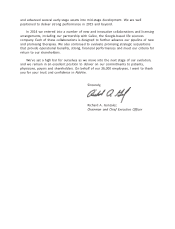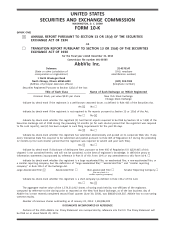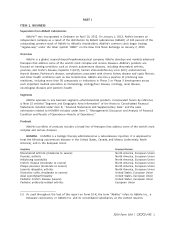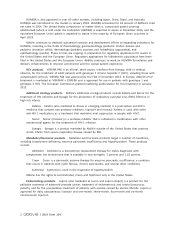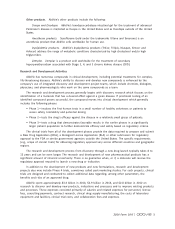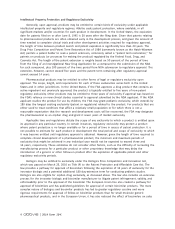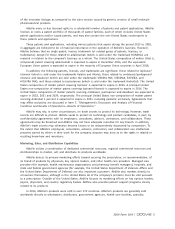AbbVie 2014 Annual Report Download - page 13
Download and view the complete annual report
Please find page 13 of the 2014 AbbVie annual report below. You can navigate through the pages in the report by either clicking on the pages listed below, or by using the keyword search tool below to find specific information within the annual report.
13NOV201221352027
Environmental Matters
AbbVie believes that its operations comply in all material respects with applicable laws and regulations
concerning environmental protection. Regulations under federal and state environmental laws impose
stringent limitations on emissions and discharges to the environment from various manufacturing
operations. AbbVie’s capital and operating expenditures for pollution control in 2014 were approximately
$3 million and $26 million, respectively. Capital and operating expenditures for pollution control in 2015 are
estimated to be approximately $4 million and $28 million, respectively.
Abbott was identified as one of many potentially responsible parties in investigations and/or
remediations at several locations in the United States, including Puerto Rico, under the Comprehensive
Environmental Response, Compensation, and Liability Act, commonly known as Superfund. Some of these
locations were transferred to AbbVie in connection with the separation and distribution, and AbbVie has
become a party to these investigations and remediations. Abbott was also engaged in remediation at
several other sites, some of which have been transferred to AbbVie in connection with the separation and
distribution, in cooperation with the Environmental Protection Agency or similar agencies. While it is not
feasible to predict with certainty the final costs related to those investigations and remediation activities,
AbbVie believes that such costs, together with other expenditures to maintain compliance with applicable
laws and regulations concerning environmental protection, should not have a material adverse effect on the
company’s financial position, cash flows, or results of operations.
Competition
The markets for AbbVie’s products are highly competitive. AbbVie competes with other research-based
pharmaceuticals and biotechnology companies that discover, manufacture, market, and sell proprietary
pharmaceutical products and biologics. For example, HUMIRA competes with a number of anti-TNF and
other products that are approved for a number of disease states and AbbVie’s virology products compete
with protease inhibitors and other anti-HIV treatments. The search for technological innovations in
pharmaceutical products is a significant aspect of competition. The introduction of new products by
competitors and changes in medical practices and procedures can result in product obsolescence. Price is
also a competitive factor. In addition, the substitution of generic pharmaceutical products for branded
pharmaceutical products creates competitive pressures on AbbVie’s products that do not have patent
protection.
Biosimilars. Competition for AbbVie’s biologic products is affected by the approval of follow-on
biologics, also known as ‘‘biosimilars.’’ Biologics have added major therapeutic options for the treatment of
many diseases, including some for which therapies were unavailable or inadequate. The advent of biologics
has also raised complex regulatory issues and significant pharmacoeconomic concerns because the cost of
developing and producing biologic therapies is typically dramatically higher than for conventional (small
molecule) medications, and because many expensive biologic medications are used for ongoing treatment
of chronic diseases, such as rheumatoid arthritis or inflammatory bowel disease, or for the treatment of
previously untreatable cancer. Significant investments in biologics infrastructure and manufacturing are
necessary to produce biologic products, as are significant investments in marketing, distribution, and sales
organization activities, which may limit the number of biosimilar competitors.
In the United States, the FDA regulates biologics under the Federal Food, Drug, and Cosmetic Act, the
Public Health Service Act, and implementing regulations. The enactment of federal health care reform
legislation in March 2010 provided a pathway for approval of biosimilars under the Public Health Service
Act, but the approval process for, and science behind, biosimilars is more complex than the approval
process for, and science behind, generic or other follow-on versions of small molecule products. This added
complexity is due to steps needed to ensure that the safety and efficacy of biosimilars is highly similar to
that of an original biologic, such as HUMIRA. Ultimate approval by the FDA is dependent upon many
factors, including a showing that the biosimilar is ‘‘highly similar’’ to the original product and has no
2014 Form 10-K 7


